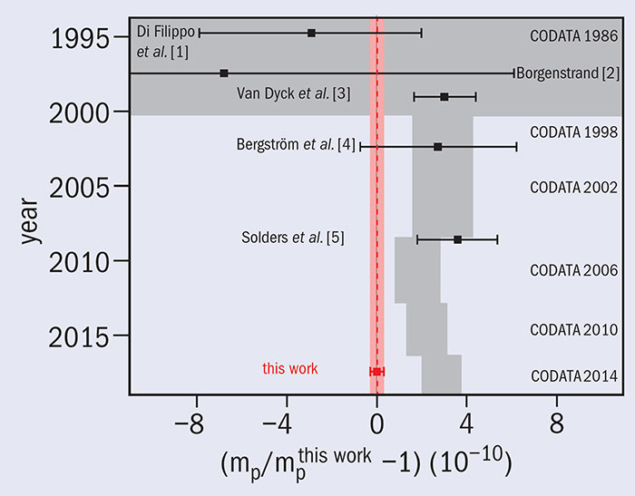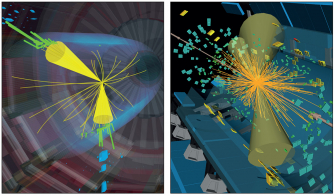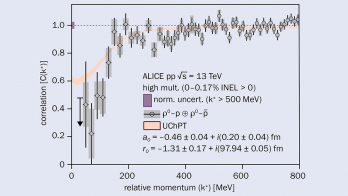
A team in Germany has made the most precise measurement to date of the mass of a single proton, achieving a precision of 32 parts-per-trillion (ppt). The result not only improves on the precision of the accepted CODATA value by a factor of three but also disagrees with its central value at a level of 3.3 standard deviations, potentially shedding light on other mysteries surrounding the proton.
The proton mass is a fundamental parameter in atomic and particle physics, influencing atomic spectra and allowing tests of ultra-precise QED calculations. In particular, a detailed comparison between the masses of the proton and the antiproton offers a stringent test of the fundamental CPT invariance of the Standard Model.
The team at the Max Planck Institute for Nuclear Physics (MPIK) in Heidelberg and collaborators from RIKEN in Japan used a bespoke electromagnetic Penning trap cooled to 4 K to store individual protons and highly charged carbon ions. By measuring the characteristic cyclotron frequencies of the trapped particles using ultra-sensitive image-current detectors, the mass of the proton in natural units follows directly.
For the new measurement, the team stored one proton and one highly charged carbon ion in separate compartments of the apparatus and then transported them alternately into the central measurement compartment. Purpose-built electronics allowed the proton to be interrogated under identical conditions as the carbon ion, despite its 12-fold lower mass and six-fold smaller charge, and the ratio of the two measured values results directly in the proton mass in atomic units: 1.007276466583±15 (stat)±29 (syst).
The sensitive single-particle detectors were partly developed by the RIKEN group, drawing on experience gained with similar traps for antimatter research at CERN’s Antiproton Decelerator (AD) – specifically the BASE experiment. “The group around Sven Sturm and Klaus Blaum from MPIK Heidelberg, which did the measurement, has great expertise with carbon, whereas the BASE group contributed proton expertise based on 12 years dealing with protons and antiprotons,” explains RIKEN group leader and BASE spokesperson Stefan Ulmer. “We shared knowledge such as know-how on ultra-sensitive proton detectors and the ‘fast-shuttling’ method developed by BASE to perform the proton–antiproton charge-to-mass ratio measurement.”
Interestingly, the new value of the proton mass is significantly smaller than the accepted one and could therefore be linked to well-known discrepancies in the mass of the heaviest hydrogen isotope, tritium. “Our result contributes to solving this puzzle, since it corrects the proton’s mass in the proper direction,” says Blaum. The result also improves the proton–electron mass ratio by a factor two, achieving a relative precision of 43 ppt, where the uncertainty arises nearly equally from the proton and the electron mass.
Although carefully conducted cross-check measurements confirmed a series of previously published values of the proton mass and showed that no unexpected systematic effects were imposed by the new method, such a striking departure from the accepted value will likely challenge other teams to revisit the proton mass. The discrepancy has already inspired the MPIK-RIKEN team to further improve the precision of its measurement, for instance by storing a third ion in the trap and measuring it simultaneously to eliminate uncertainties originating from magnetic-field fluctuations, which are the main source of the systematic error using the new technique.
“It is also planned to tune the magnetic field to even higher homogeneity, which will reduce additional sources of systematic error,” explains BASE member Andreas Mooser. “The methods that will be pioneered in the next step of this experiment will have immediate positive feedback to future BASE measurements, for example to improve the precision in the antiproton-to-proton charge-to-mass ratio.”







